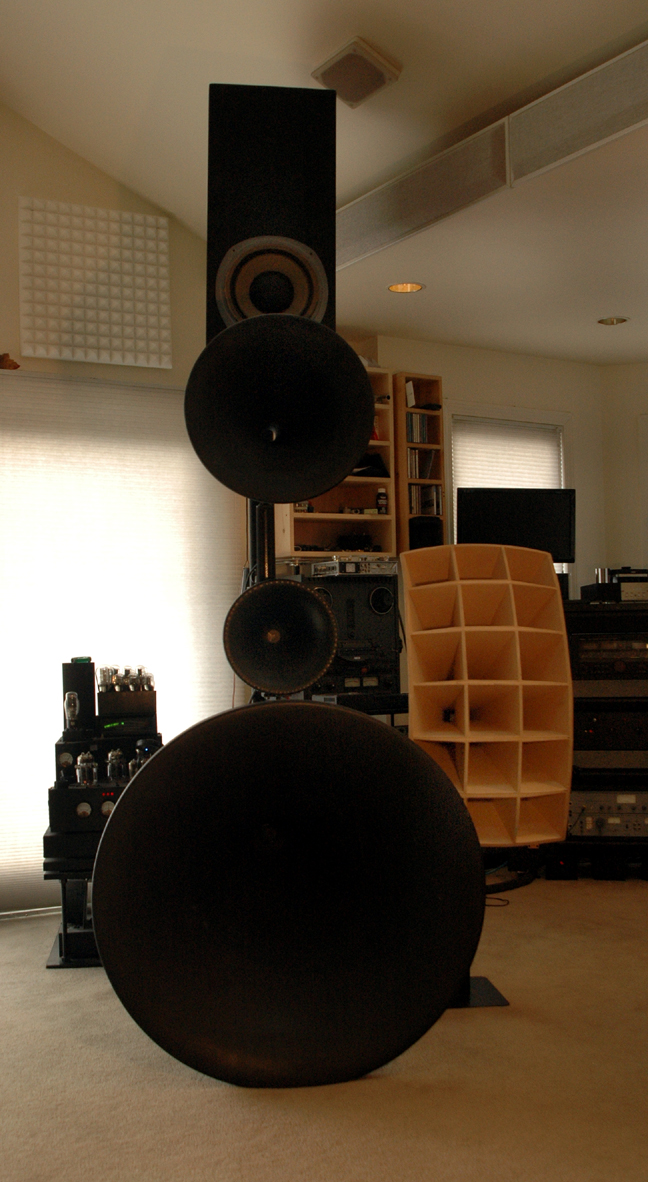|
fiogf49gjkf0d
My 18-cell is a classic 18-cell very similar of the one that the guy from Sweden built:
http://www.diyaudio.com/forums/multi-way/136964-construction-multicell-horn.html
The difference is that my multicell has 3 extra cells and outer skin that allow the horns to be filled it with sand. I have some things that I like and do not like in my new horns but the construction of the multicell is pretty much irrelevant for what I care at this time.
Running my 18-cell full-range with my Vitavox I do see all that I like and do not like with multicells full-range. But as I said above - that “depth” of the multi-dimensionality effect is not something that might is interesting. I think the key of multicell depth are in the fact that multicells acts as error randomizer. The multicells are not perfect horns - the entrance to the multicell screen from throat is horrible, the individual cells are time misaligned to each other as they are angled, each neighboring cell acts as re-entry hors and many other problems that I might call. But the nice thing about multicells and only about multicells with many multiple cells is that error of each cell is randomized and as result made undetectable. As the result think we use with multicell horns the effect similar to the one what we in childhood when we “heard ocean” but closing large seashells to our ears.
One of the ugliest things with multicell is that fact the room is reflected in the horn. If you hear very careful then you can recognize that sound eco itself in multicell. It feels like multicell acts as an array of self-shorted Helmholtz resonators. Some people managed to do it even with a single cell horn (for instance the large conical Congent MF horn at CES had VERY strong this effect for some reasons). The multicell horn has this effect much stronger. However, I think if to recognize this effect and if to control it sensibly and creatively is possible.
So, what multicell my new 18-cell has to do with Macondo? Good question. First of all I would like it to be not 18-cell but 14-cell or 30-cell, the more is better. The initial idea was to replace my Fundamental Channel with larger with restricted height but as now I can see that this idea will not work. The 183Hz slow opening horn is too long for my current Macondo frame and it will break time alignment among with a few other Macondo things. It is possible to accommodate this 18-cell with Macondo but it will take to make another frame. I do not want to do it as I do not feel that cost-benefit will be significant.
Experimenting with my multicell I come to a very interesting idea that if I use multicell in HF-restricted more and driver via it only Fundamental Channels spectra then I can set my 18-cell way off the Macondo and try to attack with it the Macondos’ width-modulation. I have written about it in the following article:
http://www.GoodSoundClub.com/TreeItem.aspx?PostID=15000
So, I think to position the multicell vertically on the outer sides of Macondo and to see if I will be able to convert my 18-cell into with-modulating channel. I would need to assess how it all works all together only what playback works perfectly it means that after my PP2000 come back. I will see if this type of Fundamental Channel offset will be useful. I think it will be but it will be necessary to set the thing up very sensibly. Below is a phonograph of the Macondo rig channel with added width-modulating multicell. The picture is made from the Listening chair and it gives an idea what I am trying to do. The time will show if it works.

Regarding the drivers. Will see. There are a number of drivers out there that can go for 300Hz or lower but I do not know at this point what kind sound I would like to have from this channel. It obviously will be some that would go lover then S2/S3 but I do not know how much transients the width modulator will handle. It is possible that the width-modulating multicell will demands a very soft sounding driver, so I will be looking in it with time. For now I need to paint this horn in black as soon as possible….
Rgs, Romy the Cat
"I wish I could score everything for horns." - Richard Wagner. "Our writing equipment takes part in the forming of our thoughts." - Friedrich Nietzsche
|